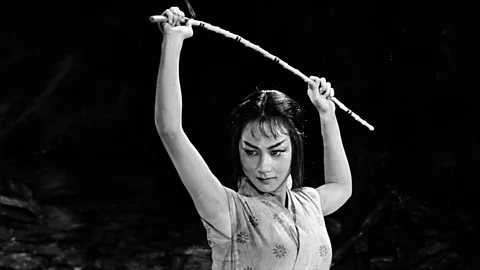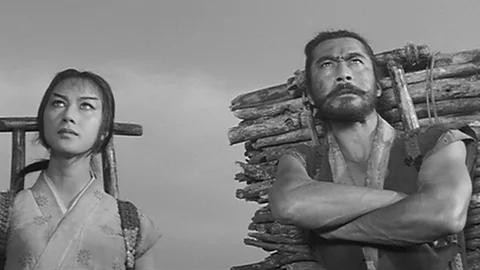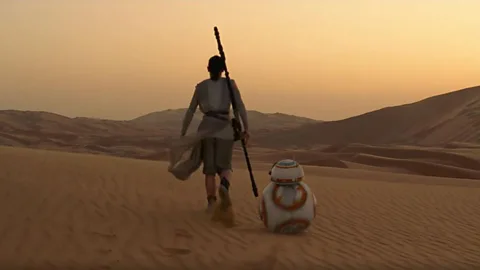The film Star Wars stole from
 Criterion
CriterionGeorge Lucas has acknowledged that Akira Kurosawa’s The Hidden Fortress inspired parts of his own saga. Nicholas Barber looks at just how far the similarities go.
It’s a brilliantly unconventional angle for a galaxy-spanning sci-fi adventure, but George Lucas, the writer-director of Star Wars, didn’t have to think too hard to come up with it. As he has often acknowledged, he simply borrowed the idea from Akira Kurosawa’s 1958 samurai classic, The Hidden Fortress. “The one thing that really struck me about The Hidden Fortress,” he said in 2001, “was the fact that the story was told from the [perspective of] the two lowest characters. I decided that would be a nice way to tell the Star Wars story, which was to take the two lowest characters, as Kurosawa did, and tell the story from their point of view, which in the Star Wars case is the two droids.”
Kurosawa was already a big name in Japanese cinema when he caught the world’s attention with Rashomon, an intricate crime drama which won the top prize at the Venice Film Festival in 1951. The New Hollywood wunderkinds – Martin Scorsese, Francis Ford Coppola, Steven Spielberg – were entranced by his artistic, philosophical, yet dynamic work. Here was a writer-director from an intriguing foreign culture, but because he was so influenced by John Ford and other American directors, his films were accessible to Western audiences. “Let me say it simply,” summed up Scorsese in 2009. “Kurosawa was my master.”
Some international directors didn’t just learn from Kurosawa’s deep-focus vistas and propulsive editing, they remade his films wholesale. The Seven Samurai (1954) became John Sturges’ The Magnificent Seven (1960). Yojimbo (1961) became Sergio Leone’s A Fistful of Dollars (1964). But it was Kurosawa’s widescreen epic The Hidden Fortress that fascinated Lucas. For one thing, it had an unusual blend of swashbuckling action and knockabout comedy, fairy-tale archetypes and war-movie grit. And for another, it showed how a civil war might look to a duo of bumbling, bickering nobodies.
 Criterion
CriterionA long time ago…
In Kurosawa’s film, the civil war takes place in 16th Century Japan, and the duo are ragged peasants, the tall Tahei (Minoru Chiaki), and the short Mataschichi (Kamatari Fujiwara). Like the droids they inspired, they can’t stop squabbling as they traipse miserably through a desert in the aftermath of a battle; and, like those droids, they split up, before being captured and reunited. Eventually, they are dragged back into the central conflict: they have to help a bearded general (Toshiro Mifune, the star of 16 Kurosawa films) escort Princess Uki (Misa Uehara) back to her homeland, just as the droids help Ben Kenobi escort Princess Leia to the rebel base. The difference is that Tahei and Mataschichi aren’t loyal servants, but opportunists with an eye on the princess’s gold. They may be C-3PO and R2-D2, but they’re Han Solo and Chewbacca, as well.
Peasants aside, Lucas has said that the similarities between Star Wars and The Hidden Fortress are “more of a coincidence than anything else”, but you don’t have to peer too closely at Kurosawa’s film to spot images, settings and techniques that crop up in Lucas’s trilogies. There is the corpulent slave owner who could be a cousin of Jabba the Hutt; there are the mossy forests which anticipate the Ewoks’ Endor; and there are the horizontal wipes which both directors use to transition between scenes.
 Lucasfilm
LucasfilmLucas even considered Mifune for the role of Ben Kenobi, who had formerly been a general himself during the Clone Wars. And if you’ve ever been bemused by the utter pointlessness of Queen Amidala disguising herself as her handmaid in The Phantom Menace, you can trace her subterfuge back to Princess Uki pretending to be a mute commoner so that she can travel undetected through enemy territory. Besides, can it really be a coincidence that at the end of The Hidden Fortress, the heroes are saved by a facially scarred villain who has a last-minute change of allegiance, much like Darth Vader in Return of the Jedi?
Of course, Lucas’s many innovations are what make Star Wars so magical – but in one respect the 1958 film seems more modern than the 1977 one, and that’s in its emphasis on Princess Uki. Lucas has said that Leia is “more of a stand-and-fight kind of princess” than Kurosawa’s heroine, but it’s hardly a fair assessment, given that Uki does actually stand and fight: when Tahei and Mataschichi first spy her in a forest, she whips them with a stick. Later, she frees a female slave from her master, and in return the grateful woman protects the princess from the peasants’ unwanted advances. Finally, it is Uki’s bravery which prompts the enemy general to switch sides. The story of The Hidden Fortress may be seen from the peasants’ perspective, but it is fundamentally the princess’s story.
The first Star Wars trilogy, in contrast, is the story of Luke Skywalker. The most significant moments are handed to the men, whether those men are humans, Wookiees or robots, and, aside from Leia, there are no female characters with much to do. When you factor in Uki’s aged servant and the freed slave, The Hidden Fortress features three times as many strong women as all three original Star Wars episodes put together – and there’s not a single gold bikini.
That bias has been corrected in The Force Awakens. The long-awaited new instalment includes a female pirate and a female stormtrooper, and Daisy Ridley’s character is a better fighter than any of her male counterparts. In fact, her poses when she wields a staff or a lightsaber could have been lifted straight from Kurosawa’s duelling generals. It looks as if Lucas’s successor, JJ Abrams, has been watching The Hidden Fortress, too.
